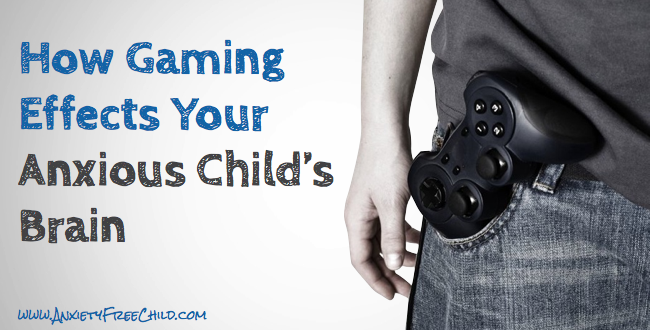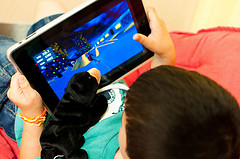 Grand Theft Auto. The Walking Dead. World of Warcraft. While these may sound like things you certainly wouldn’t want in your home, they are also things your child may regularly be embracing in the glorious world of gaming. Gaming has taken computers, tablets, smartphones and even the Internet by storm, but it can also create quite a whirlwind in your anxious child’s brain.
Grand Theft Auto. The Walking Dead. World of Warcraft. While these may sound like things you certainly wouldn’t want in your home, they are also things your child may regularly be embracing in the glorious world of gaming. Gaming has taken computers, tablets, smartphones and even the Internet by storm, but it can also create quite a whirlwind in your anxious child’s brain.
You can, however, transform the negative whirlwind of gaming into a more beneficial experience if you know exactly what children of anxious parents are up against and how to decrease the negative effects while increasing the positive.
Gaming by the Numbers
Exactly how much gaming goes may be a tough question to answer, although a quick and easy response is: “a lot.” Statistics paint a scary story, especially some from a study published in the Journal of Adolescence and others from Jane McGonigal, game research and development director at California’s Institute of the Future.
- 500 million – Number of active gamers of all ages across the globe
- 10,000 – Number of hours the average person will have spent gaming by the time he or she reaches age 21
- 95 – Percentage of American children under age 20 who play video games
- 13 – Number of hours per week the average boy spends gaming
- 5 – Number of hours per week the average girl spends gaming
The effect of all that gaming depends on several factors, such as the type of games being played, the length and limits on each session and, of course, if your child suffers from anxiety or other mental health issues. If you and your child are using a program such as the one we offer, it’s even more important to be aware of how gaming habits can create or foster child anxiety.
Gaming and Your Child’s Anxiety
 Anxious children have the tendency to foster fear and worry about things or stories created in their head rather than focusing on the reality right in front of them. Gaming may give them an escape from the worry, but it also removes them even further from reality.
Anxious children have the tendency to foster fear and worry about things or stories created in their head rather than focusing on the reality right in front of them. Gaming may give them an escape from the worry, but it also removes them even further from reality.
Psychology Today writer Victoria Dunckley notes that interacting with a screen results in excess stimulation for the child, which is not a particularly positive thing in general and certainly even less positive when children are already beset with anxiety issues. Screen interaction shifts the child’s nervous system into that all-too-familiar fight-or-flight mode, she notes, which ends up messing up biological systems that pump out adrenaline.
Your child’s anxiety symptoms can be exacerbated by extended gaming. They may also be more likely than non-anxious children to suffer from the laundry list of ill effects gaming can bring.
Gaming Ailments
Sitting in front of a computer all day at work may make you cranky and fatigued. Despite the action with which some of today’s games are packed, your anxious child can also feel that irritability and fatigue after hours in front of a screen. Additional detriments come with the territory.
Physical ailments. Before we even get into what that does to a brain, we can check out what that does to a body. Sitting in front of a screen for long hours can result in eyestrain, headache, muscle pain and stiffness, slouching and other poor postural habits and repetitive strain injuries. Have you met Mr. Carpal Tunnel yet?
Increased obesity risk. If you haven’t noticed, word around America is that we’re facing an obesity epidemic in children. Lack of physical activity and loads of idle sitting can greatly contribute to the risk of your anxious child falling prey to the epidemic.
Isolation. Long hours in front of a computer screen can result in long, lonely hours in isolation. Even if your anxious child is interacting with characters on the screen, he or she may be lacking the interaction with others that is so necessary for healthy social development. Spending great lengths of time alone can also fuel existing antisocial tendencies.
Addiction. Gaming joins drugs, alcohol, shopping and chocolate as one more substance or activity that can spawn that thing called addiction. Unlimited playing can result in obsessive behavior, compulsion to play and gaming taking over every thought and free moment in your child’s life.
Crummy sleep. Playing games too close to bedtime can hinder your anxious child’s sleep, according to a study from Rensselaer Polytechnic Institute’s Lighting Research Center. Researchers found that electronic devices that have “backlit” displays can result in the suppression of your body’s melatonin production. Melatonin is a hormone that kicks into play in darkness and dim light that signals our body it’s time to wind down and get some sleep.
Overstimulation: ‘Electronic Screen Syndrome’
 “Electronic Screen Syndrome,” or ESS, is a phrase and concept coined by the aforementioned Psychology Today writer Victoria Dunckley in response to what she sees as a modern environmental hazard. Child psychiatrist Dunckley links the increase in certain mental health disorders, especially bipolar disorder and ADHD, to the increase in time spent staring at electronic screens.
“Electronic Screen Syndrome,” or ESS, is a phrase and concept coined by the aforementioned Psychology Today writer Victoria Dunckley in response to what she sees as a modern environmental hazard. Child psychiatrist Dunckley links the increase in certain mental health disorders, especially bipolar disorder and ADHD, to the increase in time spent staring at electronic screens.
In addition to contributing to the aforementioned fight-or-flight response, excessive screen time can induce dysregulation. Dysregulation is a child’s inability to regulate his or her attention, arousal level or mood to match his or her environment. In other words, your anxious child may have an arousal level or mood that matches what happened on the screen, but not what just happened in your family room. For children who are already prone to fear and anxiety about past or future situations, dysregulation can be a dangerous thing indeed.
While the overstimulation can occur regardless of what’s in front of the child on the screen, the detriments of gaming can become even more severe when that stuff on the screen is riddled with violence.
Repeated Exposure to Violence
Many games on the market follow what we call the “violence formula” where violence is depicted as a glamorous or expected way of life. You can probably recognize a violence formula from across the room from the sounds of weaponry alone. You’ll also recognize additional elements:
 Children create the violence. Your anxious child is not only seeing violence on the screen, but he becomes a character in the game. Instead of merely watching violence, he gets to orchestrate and execute it.
Children create the violence. Your anxious child is not only seeing violence on the screen, but he becomes a character in the game. Instead of merely watching violence, he gets to orchestrate and execute it.
Violence nets rewards. Slaughtering opponents, blowing up buildings or otherwise destroying and killing things earns them rewards. They gain extra lives, billions of points and the lesson that violence is a do-able way to solve problems since it always seems to get them what they want. What they won’t find is any realistic results of all the violence; it’s instead made to seem non-consequential and, well, fun.
Violence is constant. The Raising Children Network, an Australian parenting website, says too much violence is violence that occurs more than once or twice in 30 minutes of play. Games that have little or no non-violent scenes, or only use non-violent scenes as boring transitions, are totally engaging in overkill (excuse the pun).
You may already be able to see where this violence formula could take your anxious child, and that place is not very pretty.
Effects of Violent Games
The same Journal of Adolescence study that told us how much time boys and girls spend gaming per week also tells us repeatedly playing violent games can lead to repeatedly detrimental behavior. Children who are consistently exposed to violent games are generally more aggressive. They are also more likely to start fights with their peers, engage in confrontations with their teachers and end up with an overall decline in school achievement levels.
Another study, this one published in the Personality and Social Psychology Bulletin, found that children exposed to violence that is continually repeated through a game found a brand new skill. The researchers said the children were able to “automatically prime aggressive thoughts.” This newfound skill resulted in a high aggression levels any time the children stumbled upon confrontation in real life.
It may not be a surprise that continuous exposure to repeated violence brought on violence, as repetition just so happens to be a longstanding teaching method to help kids learn.
Additional effects of violent media were pointed out in a joint statement offered by a half-dozen medical and health organizations, ranging from the American Academy of Pediatrics to the American Psychiatric Association. Their statement, which they presented at the 2000 Congressional Public Health Summit, pretty much summed it all up. It noted children exposed to loads of violence are:
- More likely to use violence to settle things
- View violence as acceptable behavior
- Become desensitized to real-life violence
- Less likely to help victims of violent behavior in real-life
- Perceive the world as a mean and violent place
- More likely to engage in self protective behaviors
- Less likely to trust other people
- More likely to carry violence as a way of life throughout their entire life
There is a tidbit of good news in all this. A study by one of the same researchers who worked on the Journal of Adolescence report found that aggressive behavior was linked to the amount of time kids are allowed to play these violent games. Most of the teens had no parental time limitation on how many hours they could spend killing things on the screen. Most of the parents had no clue what type of rating the games received from the Entertainment Software Rating Board, which gives games the same type of ratings movies get from their Rating Board.
Positive Effects of Gaming
 Don’t throw those joysticks out the window just yet, as there are several positive effects of gaming. The benefits of gaming depend on several factors, with moderation being one of the vital keys. The amount of benefits your anxious child can reap also depends on the type of games he or she plays and if the game is set up for solitary play or more than one player.
Don’t throw those joysticks out the window just yet, as there are several positive effects of gaming. The benefits of gaming depend on several factors, with moderation being one of the vital keys. The amount of benefits your anxious child can reap also depends on the type of games he or she plays and if the game is set up for solitary play or more than one player.
Benefits noted by the Raising Children Network touched on the developmental, social and educational levels. Hand-eye coordination tops the list of developmental benefits, followed by enhanced motor skills and increased problem-solving, planning and decision-making abilities. Kids can learn to manage their resources and potentially build self-esteem as they progress through higher levels of the game.
If the game is set up for more than one player, kids can learn about teamwork, fairness and that wholesome thing called “taking turns.”
Educationally, gaming can help with recall and cognitive skills. Go all out and opt for an educational game that incorporates math problems, logic problems or other curriculum into the mix and you have an instant online tutoring session.
Tips to Help Your Anxious Child Reap Positive Gaming Benefits
If you’ve decided not to throw the joysticks out the window, you may also want to decide on a game plan, so to speak, to help your anxious child reap the benefits and avoid the detriments of gaming.
Manage screen time. “Screen time” is how much time your anxious child spends in front of the screen every day, whether it’s to watch TV, surf the Internet or engage in gaming. The recommended screen time for kids over age 5 is no more than two hours per day. Kids aged 2 to 5 should get no more than one hour of screen time per day.
Check out the ratings – and the games. Reviewing the ratings from the Entertainment Software Rating Board and reading the blurb on the game box can go a long way toward opting for games that provide benefits rather than violence, violence and more violence. If you’re unsure if a game is right for your anxious child, try borrowing them before buying.
Interact. You can also play games with your child to further check out what a game is all about. This doubles as a way for them to teach you what they know and spend some of that together time that is often lacking in today’s hurly-burly world. Gaming or engaging in screen time together also lets you open up discussions on what they are viewing on the screen.
Go for balance. Encourage your child to include a variety of activities in his or her schedule. While he or she can still engage in screen time, help him or her mix it up a bit with some physical activities, creative projects or even hanging out or playing with friends. Balance out indoor and outdoor activities, time alone doing homework and time in social situations having fun.
SOURCES:
- http://www.pamf.org/preteen/parents/videogames.html
- http://raisingchildren.net.au/articles/video_games_playing_it_safe.html/context/481
- http://www2.aap.org/advocacy/releases/jstmtevc.htm
- http://www.wnct.com/story/20986353/casual-video-games-used-to-reduce-depression
- http://www.psychologytoday.com/blog/mental-wealth/201212/screen-free-holiday-challenge
- http://www.psychologytoday.com/blog/mental-wealth/201207/electronic-screen-syndrome-unrecognized-disorder
- http://www.uscg.mil/safety/docs/ergo_hfacs/computer_use.pdf
- Gentile, D. A., Lynch, P., Linder, J. & Walsh, D. (2004). The effects of violent video game habits on adolescent hostility, aggressive behaviors, and school performance. Journal of Adolescence, 27, 5-22.
- Bushman, B. & Anderson, C. (2002). Violent Video Games and Hostile Expectations: A Test of the General Aggression Model. Personality and Social Psychology Bulletin, 28, 1679-1686.
Photo Credit: Patrick Hoesly,Holtsman,Kitsuney,Simon Scott





